Harvesting and Preparing Prickly Pear
Prickly Pear (Opuntia) is a very flexible food source. Both the pads (nopales) and the fruit (tunas) are edible, but caution should be taken with both harvesting and preparation.
While the pads may or may not have spines, both the pads and fruit have tiny hair-like barbed thorns that are referred to as thorns or “glochids.” These easily detach and will lodge in skin or other tender membranes.
Do not rinse the cactus pads or fruit under the sink until AFTER the thorns have been removed. Some of the smaller thorns can be washed from the needle bed, but more can still be on the plant. Even if the cactus species is spineless, it still has glochids, so be sure to dethorn all Opuntia food items.
Photo Credits: Brynne McMurray, Austin Stewart, Gavin Henrie
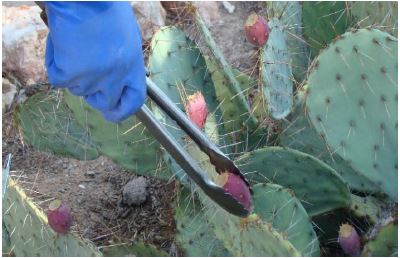
Although small, the glochids in a supposedly “dethorned” variety of Opuntia can still be dangerous and painful.
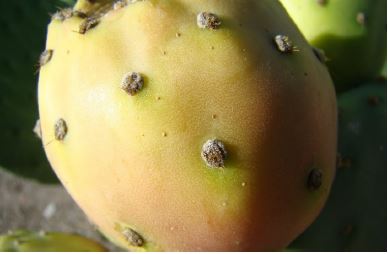
Prickly Pear Fruit
Collection should be done with leather or rubber gloves and tongs. Fruits, once harvested, will not continue to ripen, so they should be harvested ripe for the highest sugar content. Use tongs to gently twist the fruit to separate it from the pad. It’s best to put the fruit in a paper bag or some other container that will prevent the glochids from coming through.
There are various techniques for preparing prickly pear fruit. The first method is to carefully burn the fruit with an open flame from a blow torch, lighter, gas stovetop, or even a candle. The glochids burn off quite easily. The fruit can be peeled without burning it first, but it is better to err on the side of caution. The fruit can become slippery once heated, so be sure to grip the fruit tightly with the tongs. Make sure to continue to burn each spot until no new embers appear on the glochid beds or fruit.
After being burned, the fruit can be peeled. Peel the fruit by cutting off both ends of the fruit and making a slit from the top to the bottom. The cuts should resemble the letter “I”. Then carefully pull the skin from the fruit starting at the slit to reveal a dethorned fruit.
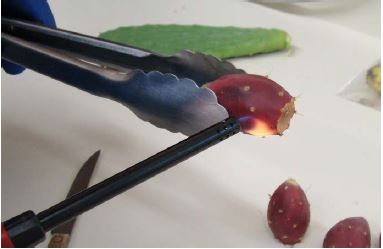
If only the juice is wanted, there are other methods of preparation. One method is to put the fruit into the freezer overnight. Once the fruit are frozen, thaw them in a lined colander suspended over a bowl or pot. A pillow case or old T-shirt between the fruit and the colander can be used as a liner. As the fruit thaws, the juice will be released and will strain into the other container, leaving the thorns, skins, pulp and seeds behind.
Another juicing technique is to place the fruit into a canning distiller. The distiller uses steam to release the juice from the fruit, which is suspended above a juice-catching bowl. The bowl is connected to a tube to dispense the juice into jars, leaving the fruit skins, seeds and glochids behind.
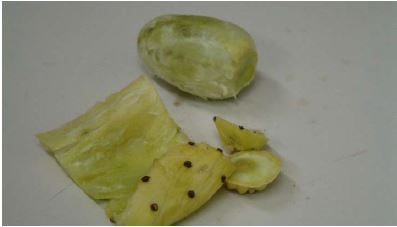
Prickly Pear Pads
Pads are harvested by using a sanitized knife to remove pads where they join a supporting pad. Using protection, either gloves or tongs, bend the pad almost to the breaking point and slice cleanly through the joint. It is recommended to harvest pads from mid-morning to mid-afternoon because prickly pear pad acid content, and therefore flavor, changes throughout the day; it is lowest at these times. Additionally, younger pads are preferred for their tenderness.
The pads are a little more difficult to dethorn, as they are the main part of the plant and, therefore, can have more noticeable and dangerous spines, along with glochids. Commercially grown nopal pads are usually of the spineless variety.
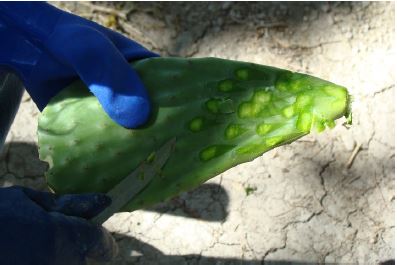
If prickly pear have spines, these spines can be taken off with a knife by cutting off the nodes or the needle beds. Once the glochids and spines are removed from both sides of the pad, the rest of the spines and glochids can be cut off by slicing the outside edge of the pad away and cutting off the bottom ½ inch of the base.
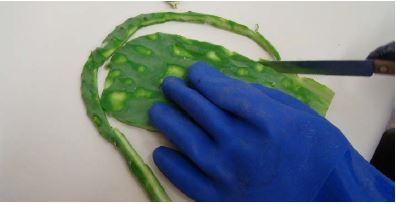
Prickly Pear Nutrition
The prickly pear fruits have an amazing nutritional base. As one of the most nutrient-packed fruits on earth, the tuna has received the title of being a “superfood.”
The Opuntia’s fruit is a great source of different vitamins and minerals, depending on the color of the fruit. The two most frequently occurring fruit are red fruit and yellow fruit. The most common are the red variety, which have a dark pink color. This type of fruit contains the most ascorbic acid of all the fruit types. This gives the fruit citric qualities and taste.
The yellow-skinned fruits have more carotenoids than their red-skinned cousins. Carotenoids are an early precursor to vitamin A, a potent antioxidant that is very helpful in preventing some cancers and heart disease. This particular nutrient also gives a boost to the immune system. Because of the change of nutrients, the yellow variety of fruits can have a more vegetable taste. This may be because carotenoids are found in orange vegetables, such as carrots and some types of squash.
Both varieties have additional shared health benefits. Prickly pears were used as a cure-all in early Native American societies. From indigestion to burn wounds, the cactus had all the answers. Both types of fruit have high counts in vitamin C and calcium. They are also high in dietary fiber, which explains why they helped with indigestion. They also contain a high amount of kaempferol, which is an additional aid against cancer and heart disease, and many antioxidants and proteins that aid the body against infection and other maladies.
Beyond that, they are also low in cholesterol, sugars and fats, making the fruit an overwhelmingly healthy treat.
Fruit or tunas are:
- High in vitamin C
- High in calcium
- High in antioxidants
- A good source of dietary fiber
- Low in calories
- Free of saturated fats and cholesterol
- Low in sodium
- Good sources of carbohydrates
- Good sources of potassium
- Good sources of magnesium
Prickly Pear Fruit
Pads or nopales:
- Contain iron and vitamin A (which are lacking or low in the fruits)
- High in vitamin C
- High in calcium
- High in riboflavin
- High in magnesium
- High in vitamin K
- High in potassium
- High in dietary fiber
- Low in calories
- Full of water for hydration
Prickly Pear Pads
The pads are also extremely nutritious, in ways the fruit may not be. Eating both the pads and the fruit results in a larger range of nutritive intake. The most notable health benefit found in the pads is their high counts of vitamin A, a powerful antioxidant. Although the fruits do have carotenoids, they don’t have the full source of vitamin A, unlike the pads.
The pads are high in other nutrients as well, such as potassium, which helps to maintain the body’s electrolyte balance. Along with potassium, the pads carry a large dose of calcium, which helps to improve bone strength and prevent osteoporosis. Similar to the fruit, the pads also contain a large amount of dietary fiber.
The pads also contain many amino acids, which are the foundations of protein. The cactus pads are also high in flavonoids, which have anti-inflammatory properties, and contain vitamin C, which absorbs iron and other nutrients into the body, and sodium.
One of the most interesting nutrients in the pads is water. Edible pads contain approximately 85 percent water. This trait makes the cactus pads a very efficient source for fodder and animal feeds. Tortoises eat the pads, flowers and fruit of the prickly pear.The high nutrient amounts and water content is highly desirable for livestock. The animals may need additional protein supplements, but if fed enough pads, the water consumption of the livestock will be significantly lower due to the water content of the cacti. This offers solutions for ranching in drought conditions and desert areas, or simply a water-saving technique for other areas.
Similar to the fruit, the cactus pads have a very low sugar and calorie count with little to no fat. The cactus truly is a superfood.
Prickly Pear Recipes
The best time to pick cacti (both fruit and pads) for food is in the morning when they will have a more citrus taste. The younger pads are preferred; the older pads have a different, less desirable taste. Younger pads are also easier to peel and to work with. To store prickly pear for further use, the juice or fruits can be frozen. The pads can be sliced and pickled, but cannot be stored fresh in a refrigerator for more than a week.
Most prickly pear tunas and nopales can be eaten plain. Prickly pear are used for a variety of foods, especially the fruit for syrups, candies and jellies. However, the pads can also be cooked or eaten in a salad. Here are a few recipes for enjoyment developed by the Conservation Aides at the Southern Nevada Field Laboratory.
Prickly Pear Lemonade:
Ingredients:
- 1/4 cup cactus juice
- 2 lemons
- 3 cups sugar
- 4 1/2 cups water
Juice the prickly pears and the lemons. Combine the juices, add the sugar and stir. Once the sugar is dissolved, add the water and enjoy!
Makes about 2 pints.
Cactus Jelly:
Ingredients:
- 4 cups cactus fruit juice (½ lemon juice can be substituted if desired)
- 5 cups sugar
- 2 packages of pectin
Put juice in a large pot and bring to a hard boil. Add sugar and boil for an additional three minutes or until the mixture becomes a gel. Pour the mix into sterilized jars and seal.
Grilled Nopales:
Ingredients:
Although simple, nopales can be delicious simply grilled. Take the prepared nopales after being cut, brush olive oil onto the skin, and grill to the desired level of tenderness.
Stuffed Nopales:
Ingredients:
- 8 pads
- 1 garlic clove peeled and cut in halves
- 1 medium onion peeled and chopped thinly
- 8 slices cheese. Pepper Jack or Mexican cheese will make a sharper taste, while Gouda or cheddar will be milder.
- ½ cup flour
- 3 eggs cracked and separated
- 1 cup olive or corn oil
- Salt as desired
- Tomato sauce or salsa if desired
Despine the paddles. Put the cactus paddles and garlic in a large pot with water, cover and bring to a boil. Boil for about 15 minutes until the pads are tender but not mushy. Drain and rinse the pads.
Next, fillet the pads by cutting them in half horizontally, but leave the last inch of the paddle where it would connect to the main plant uncut. Stuff the pads with the cheese and onion. Drag the pads through the flour and set aside.
Beat the egg whites into a stiff peak and gently stir in the remaining yolks. Heat the oil. Dip the pads into the egg mixture and fry. Serve with additional sauce if desired.
Serves 8
References
- Brett, Jennifer. "What Are Carotenoids?" HowStuffWorks. N.p., 2010. Web. 15 Aug. 2016.
- Calderon-Montano, J.M., E. Burgos-Moron, C. Perez-Guerrero, and M. Lopez-Lazaro. "Result Filters." National Center for Biotechnology Information. U.S. National Library of Medicine, 11 Apr. 2011. Web. 15 Aug. 2016.
- El-Mostafa, Karym, Youssef El Kharrassi, Asmaa Badreddine, Pierre Andreoletti, Joseph Vamecq, M’Hammed Saïd El Kebbaj, Norbert Latruffe, Gérard
Kelly, Jack and Mary W.Olsen. “Problems and Pests of Agave, Aloe, Cactus and Yucca.” Arizona Cooperative Extension, p. 4, 2008.
- Lizard, Boubker Nasser, and Mustapha Cherkaoui-Malki. "Nopal Cactus (Opuntia Ficus-indica) as a Source of Bioactive Compounds for Nutrition, Health and Disease." MDPI. N.p., n.d. Web. 15 Aug. 2016.
- Meadows, Jean and Mary King. “Florida Food Fare - Prickly Pear Cactus”. University of Florida Sarasota County Extension. UF/IFAS EXTENSION SARASOTA COUNTY
- “Of Thorns, Spikes and Prickles.” Integrated Pest Management – University of Missouri, N.p., 3 Jan. 2013.
- Shetty, Anoop A., M. K. Rana, and S. P. Preetham. "Cactus: A Medicinal Food." Journal of Food Science and Technology. Springer-Verlag, 16 July 2011. Web. 15 Aug. 2016.
- Savio, Yvonne. “Prickly Pear Cactus Production.” University of California Cooperative Extension – UC Small Farm Program, N.p., July 1989.
- Tortoise Group. “Planting Prickly Pear Pads for Tortoises”. Planting Prickly Pear Pads for Tortoises
- Zeratsky, Katherine. “Does Prickly Pear Cactus Have Health Benefits?". Consumer Health. N.p., 16 Oct. 2015. Web. 15 Aug. 2016.


